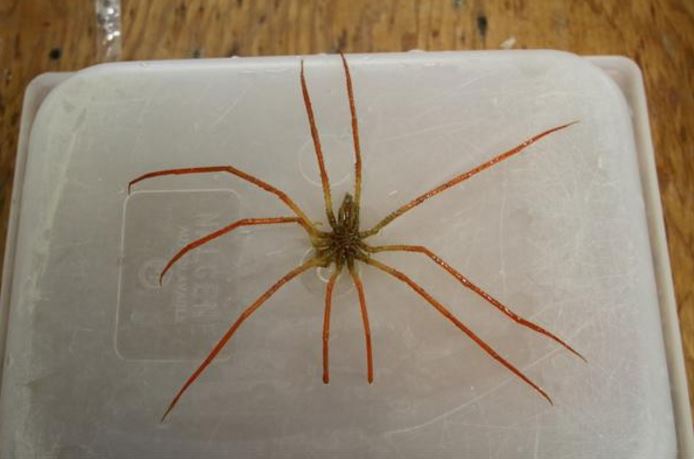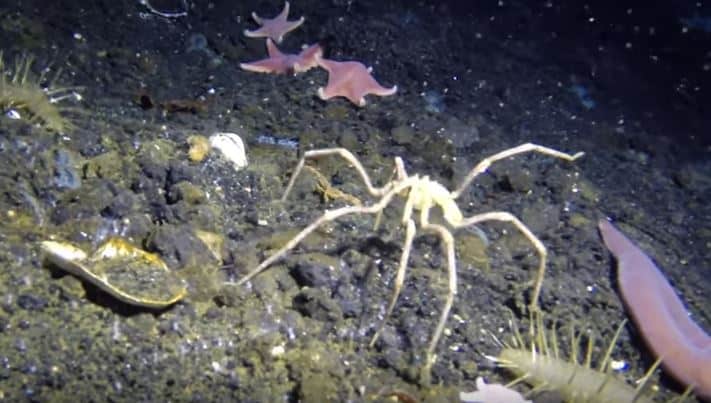Giant sea spiders, as well some other oversized creatures found in the seas around the North and South poles have long puzzled scientists, who have been unable explain why there are so many examples of Polar gigantism. In a recent study, a team of researchers suggested it may have something to do with the oxygen levels in very cold water.
Sea spiders, also known as Pantopoda or pycnogonids, are sea-dwelling arthropods known to exist in the Arctic and Antarctic Oceans, as well as the Caribbean and Mediterranean seas. There are more than 1,300 known species of them, and they range in size from 0.039 of an inch (1 millimetre) to more than 90 cm (35 inches).
Most sea spiders found in the Arctic and Southern Oceans are very small. However, scientists from the University of Montana, the University of Hawaii at Manoa, and the US Antarctic Program have found some super-big ones, measuring well over 25 cm (9.8 inches).
 Sea spiders have long legs and a very small body. The number of walking legs is usually eight (four pairs), but species with five and six pairs have been seen. A proboscis allows them to suck nutrients from soft-bodied invertebrates. Their digestive tract has diverticula extending into the legs. (Image: twitter.com/echinoblog)
Sea spiders have long legs and a very small body. The number of walking legs is usually eight (four pairs), but species with five and six pairs have been seen. A proboscis allows them to suck nutrients from soft-bodied invertebrates. Their digestive tract has diverticula extending into the legs. (Image: twitter.com/echinoblog)
In the dark, cold water of the polar oceans, sea spiders grow to become giants, with super-long legs and tiny bodies.
Technically, sea spiders, a primitive group of marine anthropods, are not arachnids (spiders).
Giant sea creatures more common near the poles
The polar waters of our planet appear to have more than their fair share of giant creatures, including echinoderms, copepods and certain species of mollusks. This phenomenon is called ‘polar gigantism’.
Scientists are unable to explain what causes polar gigantism. While several hypotheses circulate in the scientific community, none of them has yet been proven. The researchers in this latest study believe Antarctic sea spiders may have the answer.
According to Hakai Magazine, the oxygen content in the seawater just off the coast of Antarctica is especially high. High oxygen levels, plus cold temperatures which slow down creatures’ metabolic rates, could have contributed to the sea spiders’ huge size.
 When the divers reached the ocean floor, they saw it was teeming with life, including this beautiful giant sea spider. (Image: YouTube)
When the divers reached the ocean floor, they saw it was teeming with life, including this beautiful giant sea spider. (Image: YouTube)
An animal with a slow metabolism consumes less oxygen. Sea spiders have no respiratory system, and oxygen moves by diffusion – the net movement of O2 molecules from a region of relatively higher concentration (the sea) to a region of low concentration (their bodies).
Associate Professor Art Woods, who works at the University of Montana’s Division of Biological Sciences, told Hakai that large-bodied creatures require lots of oxygen for a system like this to work.
Tests carried out on giant spiders
The scientists drilled deep into the Antarctic sea ice to check the seawater and and sent a scuba diver down to grab some giant sea spiders. Seawater temperatures below the ice ranged from about -1.5 ºC to -1.8 ºC.
They tested the sea spiders they caught in conditions of different temperatures and levels of dissolved oxygen.
The researchers found that bigger sea spiders are negatively affected by low oxygen levels, which backs their hypothesis.
While this is a step in the right direction, the researchers stress that they have not yet proved conclusively that this is the true cause of polar gigantism. They believe their findings so far will help scientists who are studying other large marine creatures.
Video – Diving to find giant sea spiders
A hole was drilled into the sea ice and scuba divers went down into the crystal-clear water.

